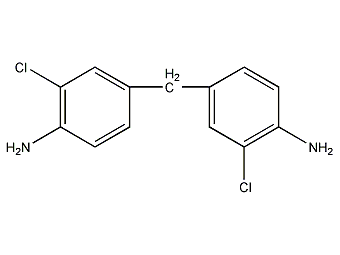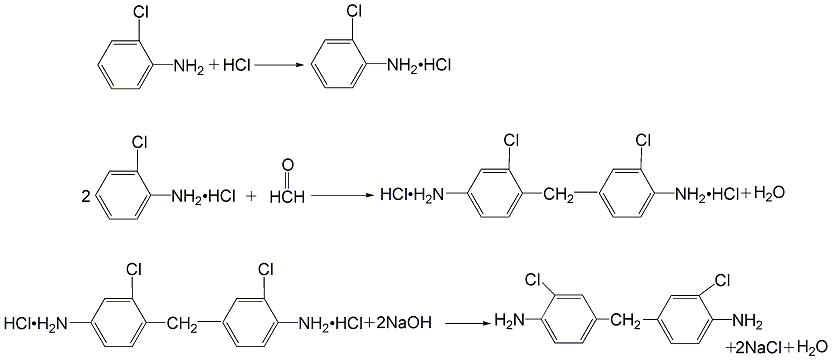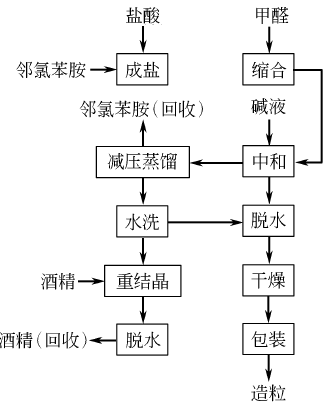
Structural formula
| Business number | 02K5 |
|---|---|
| Molecular formula | C13H12Cl2N2 |
| Molecular weight | 267.15 |
| label |
3,3′-Dichloro-4,4′-diaminodiphenylmethane, 4,4′-diamino-3,3′-dichlorodiphenylmethane, 4,4′-methylene bis-o-chloroaniline, vulcanizing agent MOCA, CH2[C6H3(Cl)NH2]2, 3,3′-Dichloro-4,4′-diaminodiphenylmethane, 4,4′-Bis(2-chloroanilino)methane, 4,4′-Diamino-3,3′-dichlorodiphenylmethane, vulcanizing agent MOCA, Vulcanizing agent for cast polyurethane rubber, Cross-linking agent for polyurethane coating adhesives, Epoxy resin curing agent |
Numbering system
CAS number:101-14-4
MDL number:MFCD00047829
EINECS number:202-918-9
RTECS number:CY1050000
BRN number:1882318
PubChem number:24884819
Physical property data
1. Properties: White to light yellow loose needle crystals, which turn black when heated. Slightly hygroscopic.
2. Density (g/mL, 25℃): 1.44
3. Relative vapor density (g/mL, air=1): Undetermined
4. Melting point (ºC): 101~104
5. Boiling point (ºC, normal pressure): Undetermined
6. Boiling point (ºC, 0.3mmHg): 202~214
7. Refractive index: Undetermined
8. Flash point (ºC): Undetermined
9. Specific rotation (º): Undetermined
10. Autoignition point or ignition temperature (ºC ): Undetermined
11. Vapor pressure (mmHg, 20ºC): Undetermined
12. Saturated vapor pressure (kPa, ºC): Undetermined
13. Heat of combustion (KJ/mol): Undetermined
14. Critical temperature (ºC): Undetermined
15. Critical pressure (KPa): Undetermined
16. The logarithmic value of the oil-water (octanol/water) partition coefficient: Undetermined
17. The upper limit of explosion (%, V/V): Undetermined
18. Lower explosion limit (%, V/V): Undetermined
19. Solubility: Soluble in dilute acids, ketones, ethers, alcohols and aromatic hydrocarbons, slightly soluble in water.
Toxicological data
None yet
Ecological data
None yet
Molecular junctionStructure data
1. Molar refractive index: 73.82
2. Molar volume (cm3/mol): 197.2
3. Isotonic specific volume (90.2K ): 541.7
4. Surface tension (dyne/cm): 56.8
5. Dielectric constant:
6. Dipole moment (10-24cm3):
7. Polarizability: 29.26
Compute chemical data
1. Reference value for hydrophobic parameter calculation (XlogP): None
2. Number of hydrogen bond donors: 2
3. Number of hydrogen bond acceptors: 2
4. Number of rotatable chemical bonds: 2
5. Number of tautomers: none
6. Topological molecule polar surface area 52
7. Number of heavy atoms: 17
8. Surface charge: 0
9. Complexity: 226
10. Number of isotope atoms: 0
11. Determine the number of atomic stereocenters: 0
12. Uncertain number of atomic stereocenters: 0
13. Determine the number of chemical bond stereocenters: 0
14. Number of uncertain chemical bond stereocenters: 0
15. Number of covalent bond units: 1
Properties and stability
It turns black when heated and is slightly hygroscopic. There is no detailed pathological test in China, so the toxicity and harm of this product cannot be determined. The sealing of the equipment should be strengthened to reduce contact with skin and inhalation from the respiratory tract to minimize harm to the human body.
Storage method
It is packed in a black plastic bag lined with a black plastic bag and a waterproof kraft paper bag on the outside. When storing, it should be sealed and protected from light and moisture.
Synthesis method
1. The crude product is obtained by reacting o-chloroaniline with hydrochloric acid to produce o-chloroaniline hydrochloride, and then adding formaldehyde dropwise for condensation. The crude product is neutralized with liquid alkali, steam distilled, washed with water, and recrystallized in dilute ethanol. Dehydrated and dried to obtain finished product.

2.Combined from the condensation of o-chloroaniline and formaldehyde
In addition to the 4,4′-para-diamine generated by the above reaction, the condensation product also contains a small amount of monoamine and triamine. Metaamines, etc., their mass fraction is generally around 10%. In fact, the initial melting point and melting point range of MOCA reflect the purity of MOCA. The production process of MOCA is as follows:

Purpose
1. This product is used as a vulcanizing agent for cast polyurethane rubber, a cross-linking agent for polyurethane coating adhesives, and a curing agent for epoxy resin. When used as a vulcanizing agent for polyurethane rubber, the dosage is generally 85% to 100% of the equivalent of free isocyanate groups in the prepolymer.
2.Used as cross-linking agent for polyurethane rubber. Can also be used to cure epoxy resins. As a chain extender for polyurethane, aromatic diamines are mainly used in the vulcanization molding of TDI series prepolymers. Aromatic diamines are less alkaline than aliphatic diamines, have lower reactivity with -NCO, have moderate gel times, and can give elastomers good physical and mechanical properties. Aromatic diamines used as castable polyurethane (CPU) generally introduce steric groups or electron-withdrawing substituents into their molecules to reduce activity and provide suitable pouring time.


